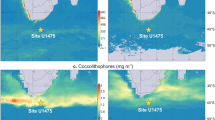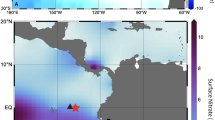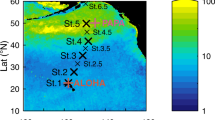Abstract
A KNOWLEDGE of past changes in the biological productivity of the oceans is important for understanding the interactions between carbon cycling and climate. Phytoplankton productivity in today's oceans can be estimated from the concentrations of chlorophyll in sea water1, but chlorophyll is not preserved in the sediments. Existing proxies for past algal productivity do not represent total productivity; for example, biogenic opal2 reflects the contribution of only part of the phytoplankton community, and the organic carbon record can be subject to contamination from terrestrial inputs2,3. Although chlorins, the pigment-transformation products of chlorophyll, are widespread in Quaternary marine sediments, their potential as proxy measures of past variations in primary productivity has not been convincingly demonstrated. Here we report a high-resolution molecular stratigraphic record of chlorin concentrations over the past 350,000 years in a sediment core from the subtropical Atlantic continental margin. Maxima in the chlorin accumulation rate coincide with significant peaks in the accumulation rates of biogenic opal (at the end of glacial terminations) and organic carbon (between terminations). These results suggest that chlorins, unlike other proxies, can serve as a measure of total primary productivity variations.
This is a preview of subscription content, access via your institution
Access options
Subscribe to this journal
Receive 51 print issues and online access
$199.00 per year
only $3.90 per issue
Buy this article
- Purchase on Springer Link
- Instant access to full article PDF
Prices may be subject to local taxes which are calculated during checkout
Similar content being viewed by others
References
Longhurst, A., Sathyendranath, S., Platt, T. & Caverhill, C. J. Plankton Res. 17, 1245–1271 (1995).
Stein, R. et al. Proc. ODP Sci. Res. 108, 361–386 (1989).
Westerhausen, L., Poynter, J. G., Eglinton, G., Erlenkeuser, H. & Sarnthein, M. Deep-Sea Res. 40, 1087–1121 (1993).
Ruddiman, W. et al. ODP Init. Rep. (A) 108, 105–219 (1988).
Sarnthein, M. & Tiedemann, R. Palaeoceanography 5, 1041–1055 (1990).
Platt, T., Sathyendranath, S. & Longhurst, A. Phil. Trans. R. Soc. Lond. B 348, 91–201 (1995).
Sarnthein, M. et al. in Upwelling Systems: Evolution since the Early Miocene (eds Summerhayes, C. P., Prell, W. L. & Emeis, K. C.) 411–728 (Geol. Soc. Spec. Pub. No. 64, London, 1992).
Eglinton, G. et al. Nature 356, 423–426 (1992).
Harris, P. G. & Maxwell, J. R. Org. Geochem. 23, 853–856 (1995).
Tiedemann, R., Sarnthein, M. & Stein, R. Proc. ODP Sci. Res. 108, 241–278 (1989).
Sarnthein, M. & Tiedemann, R. Proc. ODP Sci. Res. 108, 167–185 (1989).
Zhao, M., Rosell, A. & Eglinton, G. Palaeogeogr. Palaeoclimatol. Palaeoecol. 103, 57–65 (1993).
Stabell, B. Mar. Geol. 72, 305–323 (1986).
Pokras, E. M. & Molfino, B. Mar. Micropalaeontol. 10, 165–188 (1986).
Calvert, S. E. & Pedersen, T. F. in Organic Matter: Productivity, Accumulation and Preservation in Recent and Ancient Sediments 231–263 (Columbia Univ. Press, New York, 1992).
Sarnthein, M. et al. Palaeoceanography 9, 209–267 (1994).
Heinrich, H. Quat. Res. 29, 142–152 (1988).
Labeyrie, L. et al. Phil. Trans. R. Soc. Lond. B 348, 255–264 (1995).
Dupont, L. M., Beug, H.-J., Stalling, H. & Tiedemann, R. Proc. ODP Sci. Res. 108, 93–112 (1989).
Hooghiemstra, H. Rev. Palaeobot. Palynol. 55, 101–140 (1988).
Petit Maire, N. Palaeoecol. Afr. 12, 365–377 (1980).
Sarnthein, M. et al. in Geology of the NW African Continental Margin (eds Von Rad, U., Hinz, K., Sarnthein, M. & Siebold, E.) 545–604 (Springer, Berlin, 1982).
Tiedemann, R. thesis, Univ. Kiel (1991).
Stabell, B. Proc. ODP Sci. Res. 108, 149–156 (1989).
Poynter, J. G., Farrimond, P., Brassell, S. C. & Eglinton, G. Proc. ODP Sci. Res. 108, 387–394 (1989).
Manivit, H. Proc. ODP Sci. Res. 108, 35–70 (1989).
Walsh, J. J. Nature 350, 53–55 (1991).
ten Haven, H. L., Rullkötter, J. & Stein, R. Proc. ODP Sci. Res. 108, 351–359 (1989).
Berger, A. & Loutre, M. F. Earth Planet Sci. Letts 111, 369–382 (1992).
Zhao, M., Beveridge, N. A. S., Shackleton, N. J., Sarnthein, M. & Eglinton, G. Palaeoceanography 10, 661–675 (1995).
van Andel, T. H., Heath, G. R. & Moore, T. C. Geol. Soc. Am. Mem. 143, (1975).
Author information
Authors and Affiliations
Rights and permissions
About this article
Cite this article
Harris, P., Zhao, M., Rosell-Melé, A. et al. Chlorin accumulation rate as a proxy for Quaternary marine primary productivity. Nature 383, 63–65 (1996). https://doi.org/10.1038/383063a0
Received:
Accepted:
Issue Date:
DOI: https://doi.org/10.1038/383063a0
This article is cited by
-
Middle Pleistocene re-organization of Australian Monsoon
Nature Communications (2023)
-
Sources and Transport of Terrigenous Organic Matters Along the East China Sea Inner Shelf: Insights from Lignin and Alkane Biomarkers
Journal of Ocean University of China (2021)
-
Tracing the settlement region of massive floating green algae in the Yellow Sea
Journal of Oceanology and Limnology (2019)
-
Mid Pleistocene foraminiferal mass extinction coupled with phytoplankton evolution
Nature Communications (2016)
-
Application of orthogonal design to the extraction and HPLC analysis of sedimentary pigments from lakes of the Tibetan Plateau
Science China Earth Sciences (2016)
Comments
By submitting a comment you agree to abide by our Terms and Community Guidelines. If you find something abusive or that does not comply with our terms or guidelines please flag it as inappropriate.



